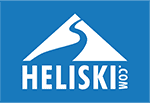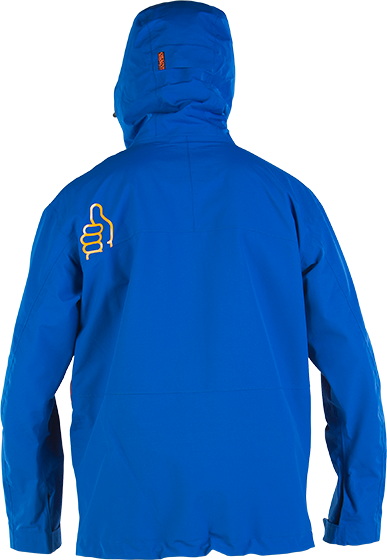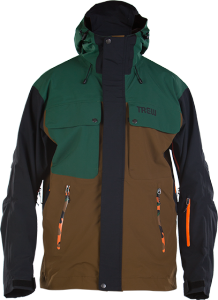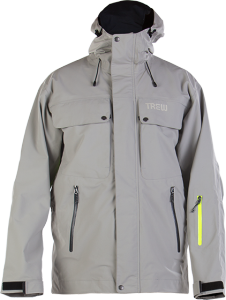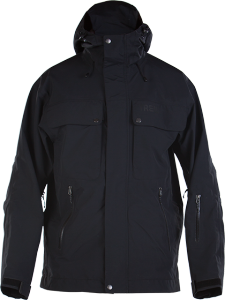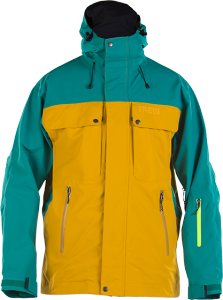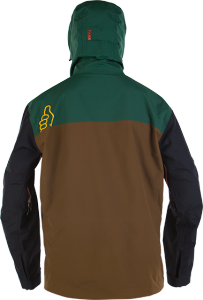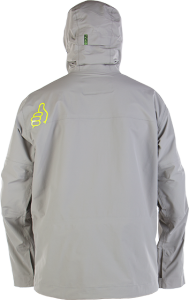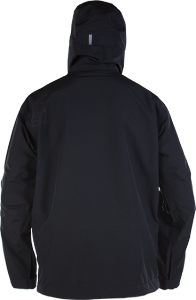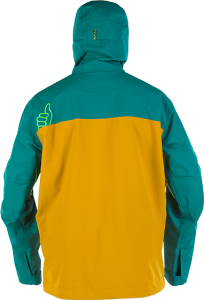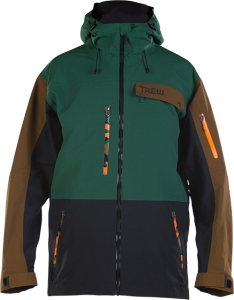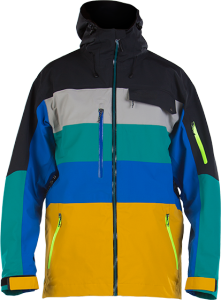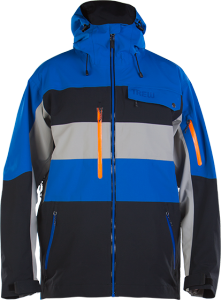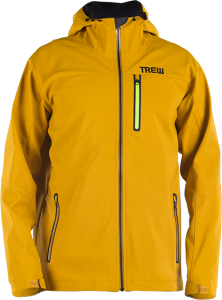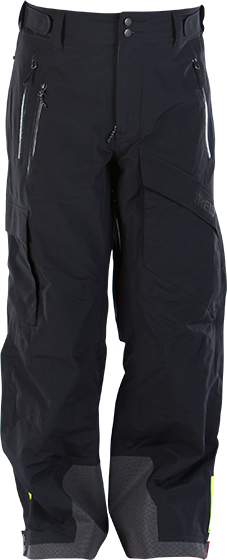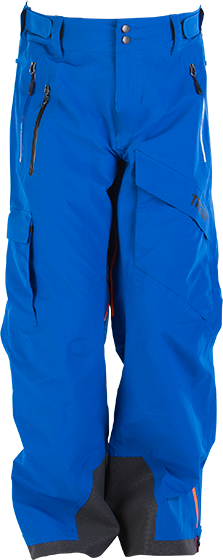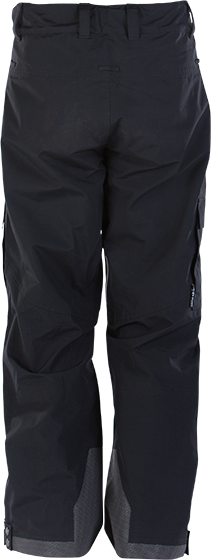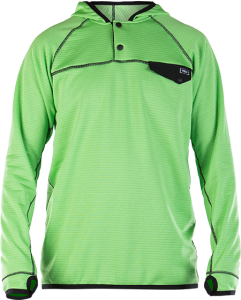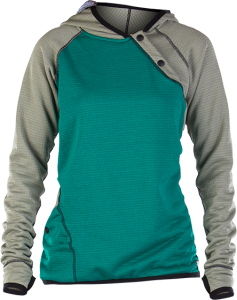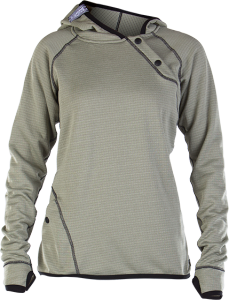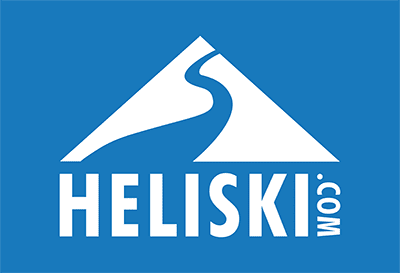TREW GEAR SKI APPAREL
Continuing our Heliski Gear Interview Series with a new company from my old stomping ground – Hood River, Oregon in the Columbia River Gorge. Tripp Frey, Co-Founder/CEO of TREW GEAR and I skyped about their innovative technylish apparel. Enjoy.
Tom (TJ): So what’s the best thing going for heli-skiers out of your TRUE GEAR line, the Cosmic?
Tripp: You know, it just depends. It’s more like a personal preference thing. Yeah, I mean the bibs are awesome.
Tom: Yeah? I love the name, TREWTH Ski Bibs, from Trew GEAR.
Tripp: You know, that was kind of our flagship product and that’s what I would be like, the bibs are where you want to be, because if you’re going to take a digger you’re going to have protection from all the snow and it’s not going to be down your pants. And it’s a super-fabric, which is really great for getting it out in the heli, and scuff guards against your skis and all that kind of stuff.
Tom: Which Trew GEAR jacket is best for heliskiing?
Tripp: On the jacket side, it’s kind of more personal preference, you know. The Cosmic [above] is kind of sleek and simple, whereas the Bellows [bellow] has like a lot of storage. So if you’re trying to bring a lot of stuff with you, then maybe the Bellows is your go-to…
Tom: I think it might be because sitting here my only complaint about this one is that I don’t really have a good goggle pocket. There’s not someplace I can get in and out of it.
Tripp: Yeah.
Tom: And in the helicopter, you get about a minute and a half from when you get in and get your seatbelt on to change from goggles to glasses or vice-versa or wipe off your goggles and that kind of stuff. So it’s got to be close, it’s got to be easy, and really almost all the shells don’t have a big enough pocket.
Tripp: You’re looking for storage, the Bellows is your one, and if you’re looking for kind of like the really progressive jacket that’s going to combine the…you know, it’s really going to embody technylish, it’s the Pow Funk. It’s kind of the most stylish, youthful that’s, you know, progressive colors. Same material. You know, it’s all the same material.
Tom: Alright. So how do you distribute Trew GEAR? How do people get Trew gear heliskiing?
Tripp: Good question. We have about 50 dealers around North America, and so you can visit or try to find a local retailer, and of course you can always find us on our website , trewgear.com. We sell gear off our website. We have online partners like backcountry.com, where you can also get our product.
Tom: You were talking about how you got into this business.
Tripp: Yeah, sure. Um, well, I moved to Hood River (OR) to work for another small little company that maybe you’re familiar with called Shred Alert.
Tom: Oh, sure, I know Heather.
Tripp: And I got to know Heather, who owned it, through a friend. And so I was just finishing grad school and came out here to work for her. Kind of had like an entrepreneurial edge, wanted to work for a small company and try to grow or do something on my own. And so I came here, worked for her—I didn’t know anyone—and I’ve just always been a passionate outdoors person, skier particularly.
But I only worked there for about six months, and then the entrepreneurial interest was too strong and so strong I called up two really good friends who were twin brothers, John and Chris Pew. They moved out here. And we kind of had this vision for technical apparel that could be done a little bit differently, and that was kind of our only kind of guiding light. And then we just felt like, “Let’s use the top-of-the-line materials, but let’s design it from a little bit of a different perspective. Let’s focus on durability. Let’s focus on utility in terms of storage and having a lot of storage options. Let’s focus on colors and making the jackets aesthetically beautiful.” And so, just kind of rethinking…although less design for pure alpinism and a little bit more design for just skiing and snowboarding.
Tom: Yeah, yeah.
Tripp: So, it might weigh a few ounces more, “Okay, fine, maybe you’re not taking on Everest. Okay.”
Tripp: But for your everyday use of inbound, side-country and hut trips, heli-skiing – it’s going to be more than sufficient. It’s going to be ideal, kind of the ‘quiver killer.’
Tom: Yeah, I like that. And it’s kind of a lower price point than, I don’t know, Arc’Teryx or some super-premium. Is that part of the philosophy or you’re right on par, do you think?
Tripp: Well, I mean I think our goal is to offer similar quality and construction techniques and fabrics. We don’t use Gore, and that’s pretty much the driver of the really high price points, is just that we don’t use Gore. We don’t necessarily believe that Gore is any better than anything else. I mean, I think from a performance standpoint, obviously they have done a remarkable job of marketing their brand and people recognize it and have recognition from both manufacturing and the end consumer.
Tom: That’s funny. It’s like Windows is to computers for an analogy – it’s that you pay a big premium for an OS that’s not great. So the price of the box is way more than it should be.
Tripp: Yeah, yeah. I mean, I think Gore-Tex is a good product too, but I actually think the best analogy is Intel. Intel has…you know, Gore-Tex, you don’t know what it looks like. It’s like a processor – you have no idea what it looks like, but when you walk into Best Buy you’re like, “Oh, I have an Intel processor. Must be the best.” But you have no idea. You never see it. You don’t…you can’t… You just…it’s a component that no one sees and understands and they market it really well.
Tom: I agree with you, and Intel is my alma mater.
Tripp: Alright.
Tom: Yeah. There are a bunch of guys out there in the Gorge that are ex-Intel.
Tripp: Right, right.
Tom: Well, that’s interesting. I never thought about Gore driving up the price. It’s kind of like, in the world of audio…I can think of another analogy, but now let’s move on. It sounds like you’re pretty busy and I want to keep moving.
Tripp: Oh, no worries.
Tom: But I think Mt. Hood is a great place to test and refine clothing. And just a quick aside, I remember on a snowboard one day standing on the edge of a little precipice, and the wind was blowing so hard it blew me backwards up the hill.
Tripp: No joke. On those winter storms, it’s like 70 MPH winds or more.
Tom: Yeah, and biting cold, a little bit heavier snow than some places, and it’s look like a moonscape. I was looking at one of your team riders and she’s standing up on what…I guess it’s Mt. Baker, but it looks like Hood, everything just covered in ice. It’s a gnarly environment, so I’m sure it’s a great place to design and test clothes.
Tripp: Yeah, it is. We get to experience a variety of weather conditions relatively close to home, everything from rain to heavy snow, and you get up high you get tons of wind. And over here we get a couple of really dry storms. We get it all, and now that we’re kind of expanding our product line. Our heritage is in kind of the technical shells. But our product line has expanded and now we have like this, which is like a synthetic insulated garment, which is a really cool take. It’s a fully reversible and really technical piece, but done a bit differently. And you know, performance – soft shell, so it has new pieces that we’ve kind of been working on that we debuted this year. So yeah, it’s a great place to kind of test all of these things out.
Cool Soft Shell – Wyeast
Tom: Cool, yeah. I got a Trew GEAR soft shells [WYEAST, above, which I love], but the hard shell for heli-skiing is the sweet spot for me.
Tripp: Yeah, yeah, I totally agree.
Tom: And so do you have a powder clause? Like how much snow do you have to get on Hood before you’re allowed to take the morning off and go make turns?
Tripp: Well, we’re still pretty small little company and there’s the three of us who founded it with one other guy, and we don’t really have a policy other than going on and using gear is of value. So, you know, every day is probably not good, but when it’s good get up there and for sure.
Tom: I hear you. That’s like me with heli-skiing – I got to, I don’t have a choice. It’s my job.
Tripp: Yeah, it’s a rough life.
Tom: And so I guess I didn’t know the Shred Alert connection in the era. Shred Alert spinoff – that sort of cracks me up.
Your design philosophy, you mentioned you do it differently, and that’s differently as in the attributes you mentioned, which were the technical yet maybe a little bit more stylish?
Tripp: You know, we have this word that we use, “Technylish,” which is technical and stylish.
Tom: I love it.
Tripp: It’s kind of one of our approaches, technylish. Again, I mean, I think our lack of a background in technical garments has pros and cons, but when we sit down and think about a garment we don’t have the pedigree that someone who worked or has training in apparel construction who went to school for it and has worked at a big company, so we kind of just think more about what does our customer want and what do we want. And someone who had years of training might say, “Well, we can’t do that because we can’t have this price point and we can’t…you know, this is going to use too much fabric here and that doesn’t make any sense…”
It’s just when you’re free of the paradigms of someone who has a background in working in a big company with a lot of structure, we think it allows your outfit to kind of be a little bit more creative.
Tom: I think you’re exactly right. I remember at Intel when they went from the 486 to the Pentium they took a completely new team. So they didn’t use anybody who had designed in the 486 era because they wanted to avoid people saying, “Oh, you can’t do that. You can’t do it this way,” or, “That won’t work,” you know?
They wanted a fresh start, which to me, for a company that big literally betting the company on that, is mind-blowing, but I like the approach.
Tripp: Of course there are downsides and that’s that unforseen consequences of doing certain things and stuff not always working out how you envisioned it, but I think for the most part it’s a positive more than a negative.
Tom: Cool. And do you take a look at competitors? Like you’ve got Columbia sort of a neighbor here, but Columbia Acr’Teryx, North Face, the usual suspects. Do you get one of each of their jackets like an auto manufacturer does and kind of deconstruct it or see what they’ve done or are you literally starting with a blank slate?
Tripp: Um, no. We definitely obviously keep our pulse on the competitive landscape. We do a couple of other things. One, we look at like…we try to look at different information in terms of what product categories are selling well, which would be like this. So this is like the synthetic…like the Patagonia, Nano is probably their bestselling piece.
They don’t…no one really sells that many technical shells. So this is where you got to get your volume up and you got to start doing stuff. So we look at kind of like high-level, kind of what categories are doing well, but then within a category and where we’re looking at a particular piece, yeah, we definitely like deconstruct and buy other stuff. We’d borrow other people’s gear and take a look at it, deconstruct it. And try to learn about like what people are doing and think that we can do better.
And we’re like, “Well, what if we did that?” “Yeah, for sure.” “What if we did that?” We put our little spin on it.
Tom: So is there kind of a larger market? I’m sure you look at the market in terms of volume. I’m guessing that there’s a wannabe segment of people who want to look like they’re technical, but when they go to the mall in their four-wheel drive that they never take to the mountains… So is that a big kind of sweet-spot target or is that not part of your thinking?
Tripp: No, it is. I mean, we design our products for our core customer, and hopefully by default there are people who see that and they’re like, “Ooh, I want to be that person,” and they wear our new jacket around town.
Tom: Yeah. That’s a cool logo by the way.
Tripp: Yeah, thanks. I don’t know how anyone does…or why anyone else didn’t trademark it, but they hadn’t, so.
Tom: I love the name too, actually. You know, at this point, I have a domain name company [nameboy.com] and I know how hard it is to get a domain, let alone a trademarkable, recognizable term, so it’s cool.
Tripp: Yeah, yeah, , and…I’m the T-R in Trew, and then the two guys that I work with, their last name is Pew, P-E-W, so we’re kind of Tripp and Pew put together.
Tom: Wow. Because these days I’m seeing so many brands that are just kind of a different spelling on a recognizable term, you know, for brandability, trademarkability. So you got both going. That’s cool.
Tripp: Yeah, so.
Tom: Do you guys…you think you have a snowboard bias at Trew?
Tripp: No. We probably sell 80% to skiers.
Tom: Oh really? I mean, heli-boarding, not snowboarding.
Tripp: Yeah, yeah. Ah, no. We’re definitely trying to do both.
Tom: I feel like Hood had a higher percentage of boarders than a lot of mountains. Do you think that’s true or not really?
Tripp: Mmm, I don’t know how many…I don’t know.
Tom: Cool. You should hit up some of the—just unsolicited advice—hit up some of the heliskiing operators and see if they would put their guides in your gear.
Tripp: Well, we do sponsor one heli operator.
Tom: Oh. Who’s that?
Tripp: Skeena Heliskiing.
Tom: Oh, no kidding.
Tripp: Up in Smithers.
Tom: Sure, I have skied with Skeena Heliskiing!
Tripp: And so we provide them with their outfits, and then they buy some stuff to sell in their store.
Tom: That’s amazing. I wonder if maybe that’s how I ended up finding you guys, because I know Jake reasonably well.
Tripp: Oh, you do? Yeah.
Tom: Yeah. Yeah, I’ve been there. Have you skied with him?
Tripp: No.
Tom: You should hit him up.
Tripp: Yeah, we are getting a couple of seats. Another thing we’re doing this year is we have this RV that we bought when we first started going. So we converted into a mobile store. So the RV’s going around to dealers in the industry events and stuff, and one of the big…the big promotion running is if you spend 100 dollars on the RV your email gets in a raffle to win a free week of heli-skiing with Skeena.
Tom: And does the website tell you where the mobile store is going to be?
Tripp: Yup, there’s a counter in there kind of updated…you know, we’re trying to keep it fresh and updated, things we’re trying to change a little bit, but yeah, if you just go there it’s trewgear.com/tour.
Tom: So who drives that thing around?
Tripp: We kind of all do but we hired a guy to do it for the winter – between now and middle of January.
Tom: Yeah, like if he’s going to go from Jackson Hole to Telluride, “I’ll see you there.”
Tripp: Yeah, he just drives and we meet him up along the way.
Tom: That’s the way to go. It’s like a rock star tour where you just…you fly the jet and you meet the crew there with all the stuff.
Tripp: That’s right.
Tom: And does it go to ski resorts, like you would see it at a resort hanging out?
Tripp: Yeah, I mean, we’re going to kind of figure that out a little bit. I mean, you know, right now there’s no resorts – we’re just kind of going to dealers. So we’re pretty much going to be in the Northwest for this next month, and then we’re going to be in the Bay Area actually in middle of November.
We’ll be in Tahoe and Reno, and then Salt Lake, and then Colorado, Jackson Hole, Sun Valley, and then that’ll be kind of it.
Tom: That’s cool. I can get those dates out to our list and see if people will show up to meet you there. That’d be cool.
Tripp: Yeah. It’s such and interesting area, such a huge city and there’s like two or three shops that are like good shops. Lombardi’s is the one that we want to be in, probably. California’s a weird place. [you can say that again] There’s not a lot of independent shops anymore.
Tom: It is a weird place for that. There’s also a great shop in Berkeley, California Ski Company, who really kind of specializes in boots but they sell gear, and I think they’re pretty good.
Tripp: Right. Yeah, there’s just not a lot of independent shops and it’s kind of like a strange situation.
Tom: Your website says, “When geopolitical instability drives you deep into the mountains to live off the land and shred glades of private pow, the TREWTH is the only bib you’ll need.” Who writes that stuff? That is classic.
Tripp: Yeah. We work with this guy—he lives in Park City—who does all of our copy.
Tom: It’s just hilarious. So what’s been the hardest part about starting a brand and getting it up and going?
Tripp: Um, my, good question. A lot of things.
Tom: I actually know Chip Wilson, who started Lululemon, and I remember the manufacturing was a huge challenge because he needed money and he needed sizeable orders, he was having it done in far-off places that you had to go visit, and it was kind of a big deal.
Tripp: That’s the biggest challenge for sure, is manufacturing. It’s getting the things you want from a faraway place, and it’s the hardest thing. And you think you ought to go just kind of like give them all these specs, and they ought to be able to just whip it up. But no. It just takes so much effort to like oversee it…
Tom: Yeah. Distance, language, culture, money, all that stuff.
Tripp: Yeah. Yeah.
Tom: Timing. What’s been the most fun part of it?
Tripp: The most fun thing is, well, that’s a good question. I mean, obviously being out there and spending time on the mountain in the gear that you make and have people recognize that it works is a pretty darn good feeling. But I think…so that’s like, on an instinctual level, that’s the best, that’s the best feeling, is when you’re like out there using your gear and you’re like, “This is so cool.”
Tom: That is cool.
Tripp: But, you know, it’s nice to know that we’re building a brand, and we’re all really committed to growing this company and getting it…keep building. We’re still a small little company. Yet somehow we managed to create the illusion that we’re some grand huge thing.
Tom: I think that’s the goal of all startups, right? I call it Operation Blowfish where you try to look like you’re much bigger than you really are.
Tripp: Yeah, so…yeah, I think we’ve done a really good job of that and… But it’s really cool to see a brand that resonates and, you know, can keep putting out products that people want.
Tom: Yeah, that’s cool. And do you get any product feedback from Jake [Skeena Heliskiing] and his guys about the gear?
Tripp: Oh yeah. Oh yeah, we got a whole, you know, long email, maybe an attached document with all kinds of feedback.
Tom: Oh, that’s cool. He’s a great guy. Have you skied with him?
Tripp: No, haven’t.
Tom: I’ve skied with a lot of great skiers – he’s probably the best I’ve ever skied with.
Tripp: Really?
Tom: Unbelievable, yeah. I mean, for 15 years in Europe he raced moguls, and so his technique is flawless, fast, smooth. The guy is just amazing.
Tripp: I got to try to get up there.
Tom: You do have to go up there. One of the problems is he’s always booked. I mean, he’s…I almost never send anybody to Jake because by the middle of summer booked with Europeans, because he draws from that same market that he used to live in.
Tripp: Uh-huh.
Tom: And I’ll bet right now he’s got one week with any availability in the whole season. Maybe hit him up for cancellations because you could hop up there pretty easily from Oregon.
Tripp: Yeah, we gave him gear and he’ll give us a couple of seats, but I just kind of got to be ready to make a move real quick and get up there.
Tom: Yeah. You have to be in shape. They ski fast. Europeans don’t mess around.
Tom: So what else do you do for fun? You’re a kiteboarder?
Tripp: Kiteboarder, mountain biker, runner, and yeah, those are kind of my standard for the Gorge [Hood River Gorge, Oregon/Washington]
Tom: Yeah, it is. I was a windsurfer, a dinosaur now, but mountain biking, and I swam, I didn’t run, but I’ve just skied too many bumps, I guess.
Tripp: Mm-hmm.
Tom: So what about neon? Back in the day we used to say, “Friends don’t let friends wear dayglow,” but now it seems to be coming back.
Tripp: Um, yeah, that’s coming back a little bit. Like this year’s line we’ve featured a little like, some neon zippers and stuff. Nothing too crazy, just kind of like little hits. I think all of the stuff is so cyclical, you know. It just comes and goes. It’ll come back.
Tom: So I wonder how you figured that out then, like what are you designing next winter stuff?
Tripp: Oh, next winter stuff has already been designed six months, seven months ago.
Tom: I mean, 2014-15 stuff?
Tripp: Yeah, seven months ago.
Tom: No kidding?
Tripp: Were early, and we’re even behind. We’re slow at the most.
Tom: A year and a half in advance?
Tripp: Easily.
Tom: Wow, that’s amazing.
Tripp: This industry is really challenging. I mean, that’s one of the biggest things, is I don’t think many people… there’s not many startups. There’s not that many startups in technical apparel because if you spend any time doing it you realize how difficult it is.
Tom: Yeah.
Tripp: There are enormous lead times with raw materials and production takes an extremely long time, and so yeah, you have to have your sample order in by May so that they can have samples here in the fall so you could take them to your dealers, because you have to get orders from Northeast and Patagonia and Marmot their orders with their retailer…retailers have to have their orders in by December 1st basically for the following season.
Tom: Wow. What if you miss it? What if you come out with neon and that year everybody’s out of neon and you’re…is the whole company at risk?
Tripp: Yeah. It’s very difficult to try to figure all that out and, you know, a lot of these retailers. It’s December and they haven’t even sold for the winter. They have no idea what’s selling, what’s not. I mean, it’s just a real…it’s a conundrum, the whole supply chain is slow and I think the people who can mix that up…and we’re trying to figure out a way to kind of shake that up. Selling more direct, selling more off of the website is one way to kind of combat that, because you can sell for cheaper, because you don’t have to build wholesale margins.
Tom: And…I mean that must be challenging in a couple of ways because if you cut out the retailer, then you’ll kill them off or lose them. So is that kind of a balancing act?
Tripp: Yeah, totally. I mean, you can’t do both. You can’t sell product direct off a website and at a low price and then also try to sell it retail. You have to choose.
Tom: Yeah.
Tripp: But, you know, the web is not going away, so.
Tom: Yeah, I know…
Tripp: Retailers who try to fight the web are fighting a losing battle.
Tom: And so at what point do you have to have the money to make the order?
Tripp: It depends. Everyone…I’m sure it’s all different with different organizations, and if you’re maybe more stylish you get better terms from your factories and stuff. Typically, it’s 50% upon placing a purchase order, and then 50% upon ship.
Tom: And then are you able to borrow that from the bank like a line of credit?
Tripp: Yup.
Tom: Yeah. And where did your startup money come from?
Tripp: Mostly just friends and family.
Tom: Yeah? That’s cool. They’re probably happy now, eh?
Tripp: Yeah, yeah, I mean, like I said we’re a small little company still. We’re not rolling in it. I promise you that.
Tom: Yeah. Are you still looking for money then, like to go…?
Tripp: No, now we’re not.
Tom: It seems to be a constant struggle – as soon as you close one round, you have to start thinking about the next one. So it’s not nice that you’re not consumed by that. I’ve done a bunch of startups and it just seems to be the way to go – as soon as you close one round you start thinking, “Alright, our next horizon is six months out and we have to have these things done by then,” and that sort of thing.
Tripp: Yeah. Yeah, no, thankfully we’re kind of in a spot where now we’re okay. Well, we’ll see. You know, we’re all trying to grow our business a lot in the next couple of years and it’s going to require some more capital somehow probably.
Tom: Yeah, and a lot of companies can succeed themselves to death when they run out of cash. How about production? I guess the only one that I’m all that familiar with is Arc’teryx. They seem to have a limited production. Like if you go try to order something in August-September, a lot of the good stuff in the colors that you want is already sold out.
Tripp: What do you mean, off their website?
Tom: Yeah, and so I wonder, is it a conscious decision they make to not end up with leftover inventory at the end year, they’d rather make it a little harder to get a hold of and not have anything left over, than they would build a whole bunch extra that may end up sitting around?
Tripp: Yeah. I mean, that’s smart. I mean, yeah, I don’t know…I know they do sell direct off their website but I’m not sure…you know, that’s the whole point of getting these preseason orders in December is so you make to order.
Tom: Yeah. Maybe it’s the pro deals. They only allocate so much for the pro deals.
Tripp: Oh yeah, they probably do limit the pro deal. I mean, if you’re looking at their process, they probably offer certain things depending on availability.
Tom: That makes sense. I’m curious, do you end up with stuff at the end of the year that you sell at Overstock or somewhere like that?
Tripp: The goal is no, but yeah, we typically do a little bit. Yeah.
Tom: Yeah.
Tripp: Most companies do. Managing your inventory is just so hard.
Tom: Yeah. And who decides what stuff you’re going to build and in what quantities? Like do you guys have discussions internally where you say, “I love this jacket,” and another guy says, “No, that one’s never going to sell,” and how do you decide how much of a commitment to make to that?
Tripp: Oh, we look at preseason buy. We have a forecasting model that we plug stuff into and it gives us kind of like bell curves on sizes and based on what people are ordering, and we look at like past year’s information in terms of what sold and kind of try to equate what colors would,, “Okay, the brown from last year is equivalent to like the green this year, that one did this well, and so forth.
Tom: Damn, that sounds like an interesting challenge.
Tripp: It is.
Tom: There’s a lot of guesstimating going on.
Tripp: Very true.
Tom: So what has been the bestseller for Trew GEAR so far?
Tripp: The bib, for sure.
Tom: Yeah?
Tripp: Yeah. It’s kind of our flagship product. When we first came out with it, no one was doing a full-on technical free-ride bib, and now everyone is doing it.
Tom: Yeah, they seemed to be just kind of bags with suspenders on them, and back in the day there was nothing to them.
Tripp: Yeah.
Tom: Like pockets and they didn’t have much in the way of features and all that. Now they’re super-high-tech.
Tripp: Now they are feature-rich for sure.
Tom: The one I ski in has kneepads, believe it or not, sewn in so when you’re kneeling to get in and out of the chopper there’s more comfy.
Tripp: Oh, excellent.
Tom: But I think that’s probably not a feature that a lot of people are going to buy.
Tripp: Who makes them?
Tom: Arc’teryx.
Tripp: They make a heli-specific pant?.
Tom: Yeah.
Tripp: Okay.
Tom: Yeah, and a guide jacket. Yeah. Again, it’s not a feature… Might be a good feature for the girls’ bib. [Laughs]
Tripp: We make a women’s bib, I’ll have to think about that.
Tom: I’ll work on the name.
Tripp: Yeah, yeah. You come up with a name. We sell the Chariot bib but we can do a spinoff of that.
Tom: [Laughs] Chariot?
Tripp: That’s the name of our women’s bib.
Tom: Okay. I’ll work on that. [Laughs] I’m sitting down picturing the logo kind of redone in a way that would be more provocative as well.
Tripp: Right. Okay. Let’s see where you’re going with that…..
Tom: [Laughs]
Tripp: Nice.
TREW GEAR Team Rider Shawnie Rasking gives the TREW thumbs up
Tom: I crack myself up. So let me see if I have any other interesting to ask you, because I digress. Oh, so have you ever been heli-skiing or heli-boarding?
Tripp: Well, I have, yeah.
Tom: Where did you go?
Tripp: Ah, went with SEABA in Haines, Alaska.
Tom: Oh, how was that?
Tripp: Yeah, well, amazing.
Tom: Alaska, man. Tell me, what was your reaction to it?
Tripp: It’s just…it’s unbelievable, the beauty, the mountains. I mean, it just really is remarkable and spectacular.
Tom: It is.
Tripp: And skiing when it’s…I mean, I spent a bunch of time in British Columbia on hut trips and stuff, heli and hut trips. And, I don’t know, I’m not sure what’s better, but Alaska or British Columbia has the best skiing on the planet. I’ve never skied in Europe but, yeah, there really is something else in…Just when you get up in the heli and you get up high and you can see the ice fields and just as far as you can see just massive peaks, and then you have the ocean and it’s just really incredible.
Tom: Isn’t that amazing? I have the same feeling. It is truly spectacular. The scenery alone, it just seems like everything’s on a bigger scale. In addition to that, it’s steep as hell, right?
Tripp: Yeah.
Tom: They probably take you to some stuff that just scares you.
Tripp: Oh yeah.
Tom: I remember standing on a peak where it wasn’t big enough for all of us to put our skis on at the same time. We had to take turns.
Tripp: Really?
Tom: And then you look all around and I couldn’t tell which way we were going down. It all looked like certain death to me. It was just amazing! And they can you stuff as steep as you want. It’s awesome.
Tripp: Yeah. No, I had the time of my life. I’ve started saving up my pennies to go to that again.
Tom: Cool. I just interviewed a guy with a new operation up there that sounded pretty cool – Black Ops.
Tripp: Yeah?
Tom: Yeah, that’ll be out, I don’t know, we’ll see in a couple of days. Hopefully the interview will be done. But yeah, I know a bunch of the guys up there, so if you go again I’ll be happy to give you advice.
Tripp: Sweet, yeah. I just kind of met the SEABA guys, through friends of friends and met Sunny and a couple of other guys and stuff, it was an amazing trip.
Tom: Cool. Anyplace else? You said heli and hut trips, so they drop you at the beginning of the week and then come get you?
Tripp: Yup. I mean, up in Canada I’ve been in Fairy Meadows Hut, I’ve been to Ice Fall and to Swordshore. All are heli in, so you get…yeah, for a week, you know?
Tom: Cool.
Trip: Then you tour for the whole week.
Tom: Yeah, that’s more hardcore. You don’t have as much gray hair as I do.
Tripp: I’ve started working on it…
TREW Eagle Heliski Pant
Tom: Cool. And so where do you like to go kiting?
Tripp: I love the Coast. I mean, around here, I prefer to go up the Coast than actually the Gorge, to be honest with you.
Tom: Uh-huh.
Tripp: I like Roosevelt if I’m going to kite the Gorge out East, but I’ve traveled, um, not recently but between five and eight years ago I went to Brazil three times.
Tom: Oh wow.
Tripp: And I’ve just been down there for a week many times and amazing kiteboarding down there. Amazing windsurfing too.
Tom: Cool.
Tripp: I like to get back to a warm-weather spot.
Tom: Yeah, I heli-skied with a guy who has set up his own kiteboarding school down in Texas…
Tripp: South Padre Island, probably.
Tom: Yeah, and he has like helmets with a microphone and headphones built in and he’s got built in two-way radio, chase…
Tripp: Jet skis, yeah. It’s a good place to learn, actually. I’ve been there a couple of times as well.
Tom: It’s shallow, right?
Tripp: Yeah, shallow. That’s a big thing for kiting. Same thing probably windsurfing, so you can stand up…if you end up downwind, you can stand up and walk back up, walk to the beach and you’re not just like flopping around in the water.
Tom: Yeah, like the Outer Banks (North Carolina) same thing.
Tripp: Yeah.
Tom: So have you guys thought about doing any crossover? I remember meeting the Da Kine founder, Rob, who had at the time of 350 SKUs. Anytime they see a problem, like they invent a little doodad to fix it. Have you thought about crossing over into summer or water sports?
Tripp: Um, a little bit but not really. I mean, we’re just trying to expand kind of our winter line and encompass kind of more lifestyle wearability, you know? Like the skis, you know, just like performance soft shells, and then next year we have like…we’re really expanding this part of our line. The stuff that people wear on a day-to-day basis, it’s not as expensive. I mean, whether it’s a 400- or a 500-dollar jacket, you know, that’s our price point for our shells, it’s not…or 700 dollars like an Arc’teryx, but it’s still pretty expensive.
Tom: Yeah.
Tripp: You know, people don’t buy that that often. So we need stuff that people even who don’t need that kind of jacket will buy.
Tom: Yeah.
Tripp: I mean, Arc’teryx is kind of the…
Tom: Price leader?
Tripp: Well, price leader, but they’re the exception to the rule. Whereas they actually do make a lot of technical…they sell a lot of technical shells. They sell three-layer Gore-Tex shells and they make leaps and bounds more than anyone else. I mean, you’d be surprised, I mean, Patagonia has like their Super Alpine Jacket, which is a really nice jacket, it’s a three-layer Gore-Tex shell, it retails for about 600 bucks, same thing as Arc’teryx, but I bet Patagonia sells a third or a quarter or less of the amount of their technical shells that Arc’teryx sells.
Tom: It’s surprising too because I would guess the Patagonia brand is much more…has much more equity than the Arc’teryx brand with the exception of the, you know, people way out on the curve who are hardcore skiers, boarders. Like my mom’s heard of Patagonia, right? I’m sure. But Arc’teryx, no way.
Tripp: Yeah, yeah, but I mean that’s like, you know, Patagonia makes…they don’t make a lot of money on the technical shells. They make money on their pants and their Nano Puffs and their fleeces.
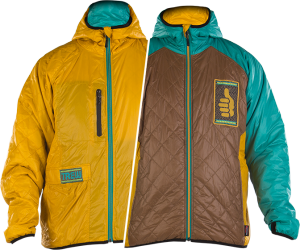
Tom: Yeah, fleeces, right?
Tripp: It’s the day-to-day kind of stuff that’s really wearable that’s how they’re making their money.
Tom: Yeah.
Tripp: They’d still make the really technical stuff because that’s really important. I mean, that’s important for their brand, just like we would never stop making our super-technical stuff, but I think even Arc’teryx sells a lot of other stuff. They sell more technical stuff than anything else, but they still sell a lot of fleeces and, you know, whatever, other shirts and jackets. They sell other stuff too.
Tom: Yeah. I mean, my introduction to them was when my luggage didn’t show up at a heli-ski lodge and there was another dude there who had an entire Arc’teryx outfit for me to use until my stuff showed up. And I was kind of bummed that my suitcase came because it was way nicer than any of my stuff…
Tom: Hey, so fleece, are you guys into that?
Tripp: We have a new fleece issue that’s 100% made in USA. It’s kind of cool. Check it out on our website.
Tom: Okay.
Tripp: It’s called The Vaporizer.
Mens Vaporizer Fleece:
Womens Vaporizer Fleece:
Tripp: And it’s Gore-Tex power-dry fleece. So that’s the super-high-performance-grid fleece and it comes from Massachusetts, and we did the cut-and-sew in Oregon, so it’s all made in the US.
Tom: Oh, cool.
Tripp: And so it has a great like mid layer, like right over your long johns.
Tom: Yeah.
Tripp: And it breathes really well, helps regulate temperature.
Tom: My typical heliskiing outfit is a base layer, then a thin mid layer, long-sleeve, and I’ll pack a vest in my backpack, and you get a…everybody who heli-skis now has to know how to tote a pack anyway. If it’s cold up with the vest on, but if it’s not That seems to work for everything because you’re in and out of the chopper so fast and you’re skiing a lot and you’re skiing five minutes between runs maybe.
Tripp: Right.
Tom: You guys make a vest?
Tripp: We have a vest coming out next year.
Tom: Cool. Next year as in 14-15?
Tripp: Yeah, 14-15.
Tom: Great. Send one to me, please.
Tripp: Sure.
Tom: I can’t believe how far ahead you have to think. That’s crazy.
Tripp: Yeah, it really is crazy.
Tom: That’s mind-blowing. I mean, you’re figuring out the product line before you… Well, I guess you do know what’s sold sort of preseason.
Tripp: Yeah, I know preseason, but yeah you’re just like creating products that are…yeah, so it’s just crazy. And from a cash flow perspective, you know, it’s like it’s kind of nuts.
Tom: So you expect some of the soft shell stuff to be popular with heliskiers, too?
Tripp: Like I was saying, the Polar Shift and The Vaporizer has kind of like great layers and pieces that accompany the shells.
Tom: Alright, cool.
Tripp: Cool. Well, I really appreciate you reaching out and giving our little company a little shout-out.
Tom: Hey, my pleasure, Tripp. Nice to meet you.
Tripp: Nice to meet you, too.
Tom: Bye. Thanks, bye.
